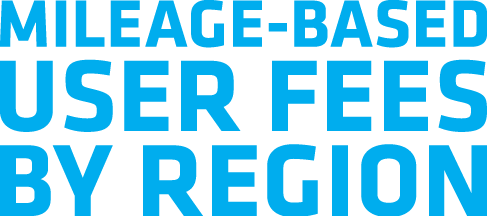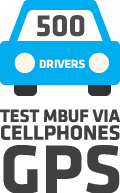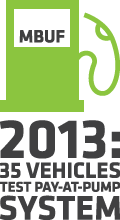
DOMESTIC
In the United States, states are taking a lead in helping to resolve many of the implementation questions by working with academia, industry partners and each other to devise mileage-based user fee pilot projects around the country.
Following is a summary of notable projects, studies and legislation around the nation. The information below has been gathered from a number of sources including, but not limited to, The Council of State Governments April 2015 brief titled, "States Explore Mileage-Based User Fees".
CALIFORNIA
California’s legislature in 2014 passed legislation requiring the California Transportation Commission to establish a task force to study mileage-based fees for two years and recommend a program to test the concept. The legislature and state officials would have to decide whether to move forward with a pilot. |
COLORADO
 |
In 2008, the Colorado Blue Ribbon Transportation Finance and Implementation Panel completed a final report to the Governor that identified a $51 billion gap in the state’s current funding versus the 2030 “cost to sustain” its infrastructure. The panel considered 39 revenue options, including VMT taxes and ultimately endorsed a pilot initiative of VMT fees for the state. |
FLORIDA
Florida lawmakers in 2015 are considering Senate Bill 1186, which would direct the Center for Urban Transportation Research at the University of South Florida to conduct a study on the viability of implementing a mileage-based user fee system. The study would inventory previous research from pilot projects in other states. It would address the assessment of technologies, behavioral and privacy concerns, equity impacts and policy implications of such a system. |
I-95 CORRIDOR
 |
The I-95 Corridor Coalition is an alliance of transportation agencies, toll authorities, metropolitan planning organizations, public safety and related organizations. The coalition conducted research on the administration of mileage-based user fees in a multi-state environment in two phases. Phase I, completed in November 2010, focused on the institutional and administrative requirements of a multi-state mileage-based system, as well as legal and regulatory issues that would need to be addressed in order to adopt such a system. Phase II, began in December 2010, and studied actual operating environments and current conditions in three adjoining states – Delaware, Maryland and Pennsylvania. Key elements of the Phase 2 report include a long-range vision concept of operations, discussion of issues associated with the transition from current functions and a cost analysis for an MBUF system. |
INDIANA
The Indiana legislature in 2014 approved legislation authorizing the state department of transportation to contract with a third party to study transportation funding alternatives, including one based on vehicle miles traveled. Each alternative studied will be evaluated on privacy, ease of use, compliance and revenue collection costs. The study is not to exceed two years. |
MINNESOTA
 |
In 2011–12, the Minnesota Department of Transportation tested a road usage charging system that relied on the use of GPS-enabled smartphones for the collection and transmission of mileage data. Participants paid different fee rates based on whether travel occurred in the Twin Cities region and whether it occurred during rush hour. |
NEVADA
 |
The Nevada Department of Transportation has conducted its own studies of mileage-based fees, largely with the aid of federal funding and state university support. A mini-field test with 40 participants concluded in 2012 used a pay-at-the-pump system and did not rely on the collection of location data. |
NEW YORK CITY
 |
The New York City Department of Transportation is proposing to develop and field test a "DriveSmart" program incorporating pay-as-you-drive insurance, feedback to motorists on fuel consumption and costs, parking incentives, dynamic ridesharing and virtual high-occupancy toll lanes. It focuses on an attractive "value proposition" to get public buy-in for mileage-based user fee pricing, and also to include other types of pricing and information services (fuel economy, eco driving, location services) as a means of accomplishing this buy-in. |
OREGON
 |
On July 1, 2015, the Oregon Department of Transportation will begin assessing a charge of 1.5 cents per mile for 5,000 drivers of cars and light commercial vehicles who have volunteered for the state’s Road Usage Charge Program, known as OReGO. As warranted, the drivers will receive a refund of the state’s gas tax. The program, which will test three different methods of collecting mileage-based fees, is the result of 2013 legislation and follows previous pilot projects in 2007 and 2012 to test such systems in the state.
|
TEXAS
 |
In 2010, the Texas Transportation Commission, which governs the Texas Department of Transportation (TxDOT), directed the Texas Transportation Institute to study the feasibility of funding highway projects through a mileage-based user fee. The purpose of the study was to evaluate mileage-based user fees as a potential revenue-generating tool for meeting the long-term transportation needs in the state. |
UNIVERSITY OF IOWA
 |
The University of Iowa conducted a multi-state field test to assess the suitability of available technology and to evaluate user acceptance of a mileage-based user fee system. The field study was based out of 12 sites, monitoring more than 2,600 volunteer participants who drove a total distance of 21 million miles throughout the United States (except Alaska and Hawaii), for an average of roughly 9,000 miles per driver. The study deployed a prototype mileage-based user fee system with an on-board unit installed in each participant’s vehicle. The unit computed mileage-based user charges for federal, state and local jurisdictions and periodically uploaded accrued charges via a cellular link to a central billing center. The center subsequently created monthly billing statements that were sent to participants. |
WASHINGTON
 |
In 2012, the Washington state legislature authorized the state transportation commission to form a stakeholder steering committee tasked with evaluating the feasibility of a road user charge and recommending potential options for a pilot test. In 2013, the legislature asked the commission to evaluate the business case for road usage charging and a policy framework was developed. The commission issued a final report to the governor and legislature in December 2014, focusing on the development of a concept of operations, the first step in putting together a systems engineering process that describes the full functionality of such a system. |
INTERNATIONAL
The notion of using distance-traveled as a mechanism for charging drivers is already being successfully implemented in several European nations (Germany, Austria, Switzerland and the Czech Republic), and in New Zealand.
GERMANY
Since as much as 35% of truck miles traveled on Germany’s motorways (Autobahn) are generated by foreign trucks, Germany’s roads face increased wear and tear from the freight traffic passing through. In 2005, because of the need for an additional source of revenue for road maintenance and expansion, Germany implemented a distance-based charge for all trucks over twelve tons (gross weight) using the motorways. Germany's Toll Collect system is a toll for trucks based on the distance driven, the number of axles and the emission category of the vehicle. |
NEW ZEALAND
The road user charges (RUC) system in New Zealand was established in 1978. Road user charges are paid on all diesel vehicles and on all vehicles over 3.5 tons. RUC rates are set according to vehicle types and weights and vary in proportion to costs to the network related to different vehicles. This is intended to encourage transport operators to make efficient choices when transporting freight, i.e. to use vehicles that balance direct operating costs and damage to roads. |
SWITZERLAND
In 2000, Switzerland began requiring the installation of the onboard units in every Swiss truck. Currently, more than 60,000 trucks regularly doing business in Switzerland carry these devices which records vehicle mileage and route information. Data is transmitted to the Swiss Customs Agency for direct billing. |
